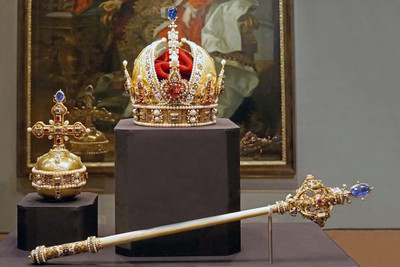The Captivating Journey of Jewelry and Gemstones throughout History
Gallery Gems on 14th Jul 2023
Introduction
Jewelry and gemstones have been an integral part of human history, not only for their aesthetic value but also for their cultural, religious, and symbolic significance. From the earliest civilizations to the modern era, jewelry and gemstones have adorned the bodies of both men and women, reflecting their status, wealth, and personal style. Let's take a journey through time and explore the fascinating history of jewelry and gemstones.
Mesopotamia: The Birthplace of Jewelry
In Mesopotamia, one of the cradles of civilization, jewelry making dates back to 3000 BCE. The people of Mesopotamia crafted jewelry from gold, silver, and precious gemstones like lapis lazuli and carnelian. These intricately designed pieces were worn by both genders, reflecting their social status and religious beliefs. Jewelry in Mesopotamia had a strong connection to their gods and was often used as offerings in temples.
Prehistory: The Origin of Adornment
Even before recorded history, prehistoric humans started adorning themselves with jewelry made from simple objects like animal teeth, shells, and stones. This early form of personal adornment marked the beginning of humanity's fascination with jewelry and gemstones. These primitive accessories served as talismans, status symbols, and even as a form of currency.
Ancient Greece and Ancient Rome: The Golden Age of Jewelry
Ancient Greece and Ancient Rome witnessed a flourishing era of artistic expression and craftsmanship when it came to jewelry. The Greeks adorned themselves with delicate gold wreaths, necklaces, earrings, and bracelets, often decorated with intricate motifs inspired by nature and mythology. The Romans, influenced by Greek culture, favored jewelry made from precious metals and gemstones. They also introduced the use of cameos, engraved gemstones portraying scenes and portraits.
Dark Ages and Middle Ages: Symbolism and Spirituality
During the Dark Ages and Middle Ages, jewelry took on a more symbolic and spiritual significance. Precious gemstones were believed to possess magical properties and could ward off evil spirits. The crosses and religious motifs found in Medieval jewelry were seen as powerful amulets, representing the wearer's devotion and protection. Jewelry during this period was predominantly worn by the noble and elite classes.
Viking Age to the Late Middle Ages: Norse Influence and Gothic Opulence
The Viking Age saw the emergence of Norse-inspired jewelry characterized by bold, intricate designs and the use of materials like amber, bone, and bronze. As the Middle Ages progressed, Gothic architecture heavily influenced jewelry design. Elaborate and ornate pieces featuring intricate filigree work, enamel, and gemstones became popular.
Early Modern Period and Ottoman Empire: Opulence and Exoticism
The early modern period witnessed jewelry styles influenced by global exploration and trade. During the Ottoman Empire, jewelry design was opulent and grandiose, featuring intricate goldwork and vibrant gemstones. Pearls, emeralds, and rubies were highly valued and used in elaborately crafted pieces that adorned the sultans and the elite.
Elizabethan Period and Age of Enlightenment: Symbolic and Philosophical
In the Elizabethan Period, jewelry became a reflection of wealth and social standing. Queen Elizabeth I adorned herself with lavish jewels, setting trends for the nobility. The Age of Enlightenment brought a shift towards more classical and symmetrical designs, with gemstones like diamonds, topaz, and amethysts becoming popular choices.
Industrial Revolution and Modern Era: Mass Production and Changing Styles
With the advent of the Industrial Revolution, jewelry production underwent a significant change. Mass production techniques enabled the availability of affordable jewelry for the middle class. The Georgian and Victorian eras witnessed a resurgence of romantic and sentimental styles, with jewelry often incorporating sentimental symbols like hearts and flowers.
The Progressive Era to the Machine Age: Artistic Movements Influence Design
In the Progressive Era in the United States, jewelry design was influenced by famous art movements like Art Nouveau and Art Deco. Unique and unconventional jewelry pieces featuring flowing lines, vibrant gemstones, and even synthetic materials became popular. The Machine Age introduced a more minimalist and geometric approach to jewelry design, reflecting the industrial progress of the time.
World War I to Space Age: Changing Landscape and Styles
The aftermath of World War I brought a shift towards lighter and more delicate jewelry designs. The Art Deco style dominated the interwar period, with its bold geometric patterns and use of colored gemstones. The Atomic Age and the Cold War saw the rise of futuristic and space-inspired jewelry designs, incorporating materials like plastics and stainless steel.
Information Age: Modern Innovations and Personal Expression
As we enter the Information Age, jewelry design has become a platform for personal expression. Modern jewelry designers blend traditional and contemporary styles, using a wide range of materials like titanium, recycled glass, and even computer-generated designs. Unique and unconventional styles, along with ethical sourcing of gemstones, are gaining popularity.
Popular Jewelry Trends and Gemstones Through History
Throughout history, certain jewelry styles and gemstones have stood the test of time. Sapphire, emerald, ruby, and diamond are enduring gemstones that have been treasured by different civilizations. In the modern era, trends like minimalist jewelry, layering necklaces, and sustainable jewelry have gained popularity, reflecting a shift towards conscious consumerism and individual style.
Royalty and the Elite: Jewelry as a Status Symbol
Jewelry has often served as a visible symbol of power, wealth, and royalty. From ancient kings and queens to modern-day celebrities, the elite class has adorned themselves with lavish jewels to flaunt their status. Crown jewels, tiaras, and statement necklaces have become iconic symbols of opulence and prestige.
In conclusion, the history of jewelry and gemstones is a testament to mankind's fascination with beauty, craftsmanship, and personal expression. From the earliest civilizations to the modern era, jewelry has evolved, reflecting the cultural, social, and technological changes of each era. Today, jewelry continues to be a cherished form of adornment, with styles and designs that cater to diverse tastes and individual preferences. So, whether you prefer a simple gold necklace or a statement gemstone ring, jewelry offers a timeless and meaningful way to showcase your unique personality and style.
